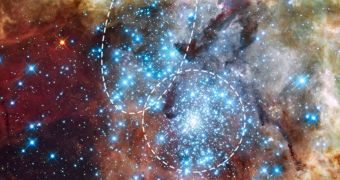One of the latest images collected using the NASA/ESA Hubble Space Telescope shows two stellar clusters in a nearby galaxy as they are beginning to collide with each other. The snapshot captures both structures at a rare moment, when they are only just starting to rip each other apart.
Many of the stars in the two clusters are massive, astronomers say. This means that each of the cosmic formation will exert a large gravitational influence on the other. Over millions of years, the overall shape of the objects will be deformed, until they finally merge.
Both clusters are located in the Large Magellanic Cloud, a dwarf galaxy orbiting the Milky Way. They are located are 170,000 light-years from Earth. By comparison, our galaxy is 120,000 light-years wide.
The collision was discovered at the core of the Tarantula Nebula, which is also known among astronomers as 30 Doradus. The objects lie right at the core of the renowned nebula, so astronomers first thought they were a single structure.
More in-depth observations revealed that the central formation was actually made up of two clusters, one of which is around 1 million years older than the other. Astronomically speaking, this age difference is not that significant but, in this case, it came in handy for experts.
The new investigation was coordinated by lead scientist Elena Sabbi. She and her team are based at the Space Telescope Science Institute (STScI), in Baltimore, Maryland. Originally, the group was looking for runaway stars at this location; stars that have been ejected from their parent star systems.
“Stars are supposed to form in clusters, but there are many young stars outside 30 Doradus that could not have formed where they are; they may have been ejected at very high velocity from 30 Doradus itself,” the expert says.
While using Hubble data to look at the core of 30 Doradus, investigators discovered that the central structure was made up of two independent clusters. Their attention was drawn by the shape of the objects, which resembled those of galaxies undergoing mergers.
“The 30 Doradus Nebula is particularly interesting to astronomers because it is a good example of how star-forming regions in the young Universe may have looked. This discovery could help scientists understand the details of cluster formation and how stars formed in the early Universe,” NASA says.
“Follow-up studies will look at the area in more detail and on a larger scale to see if any more clusters might be interacting with the ones observed,” experts from the agency add in a press release.
In a few years, after NASA launches its James Webb Space Telescope (JWST), studying such clusters and their interactions will become much easier, analysts say.

 14 DAY TRIAL //
14 DAY TRIAL //